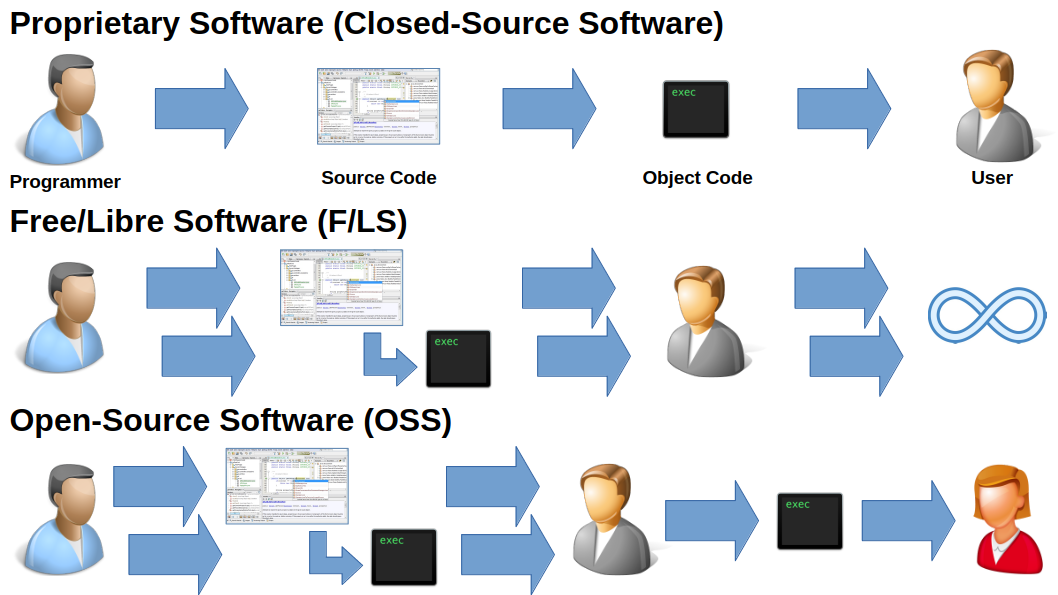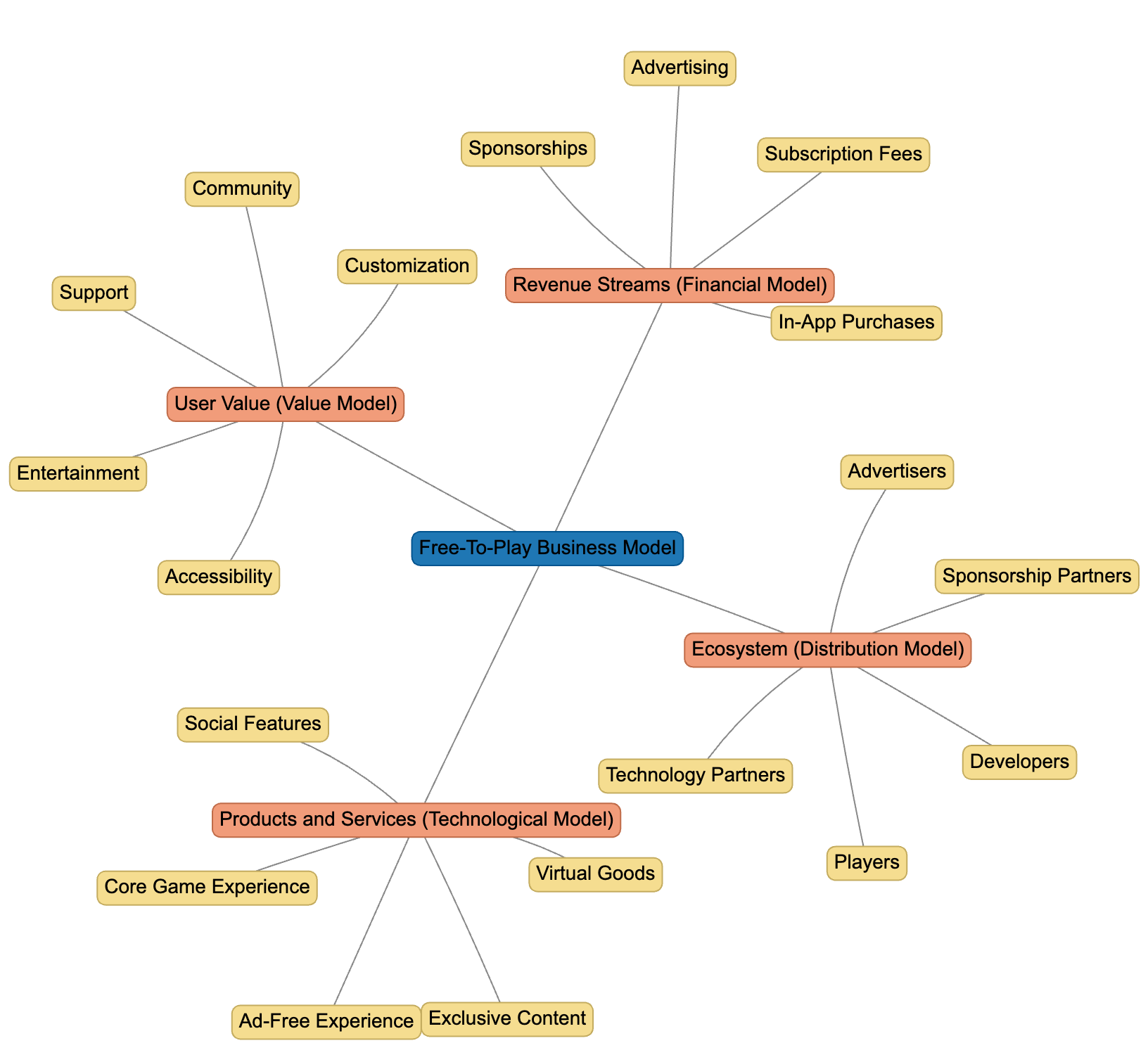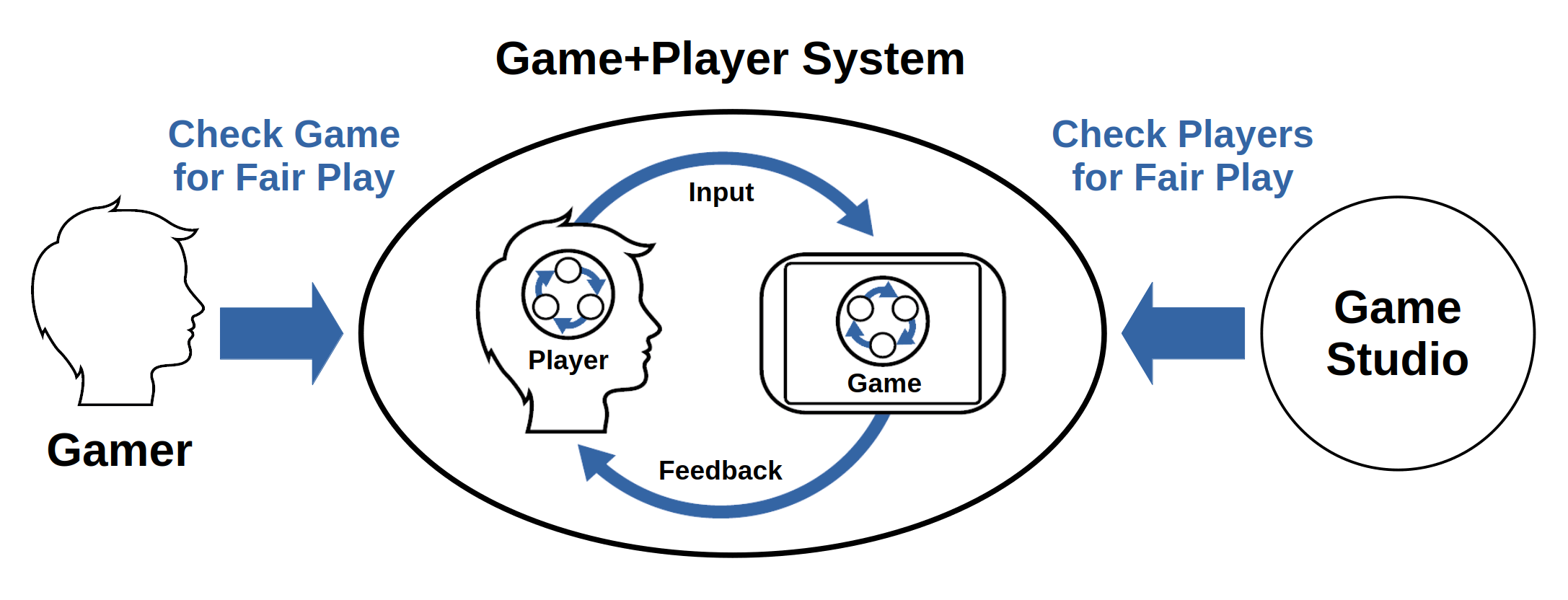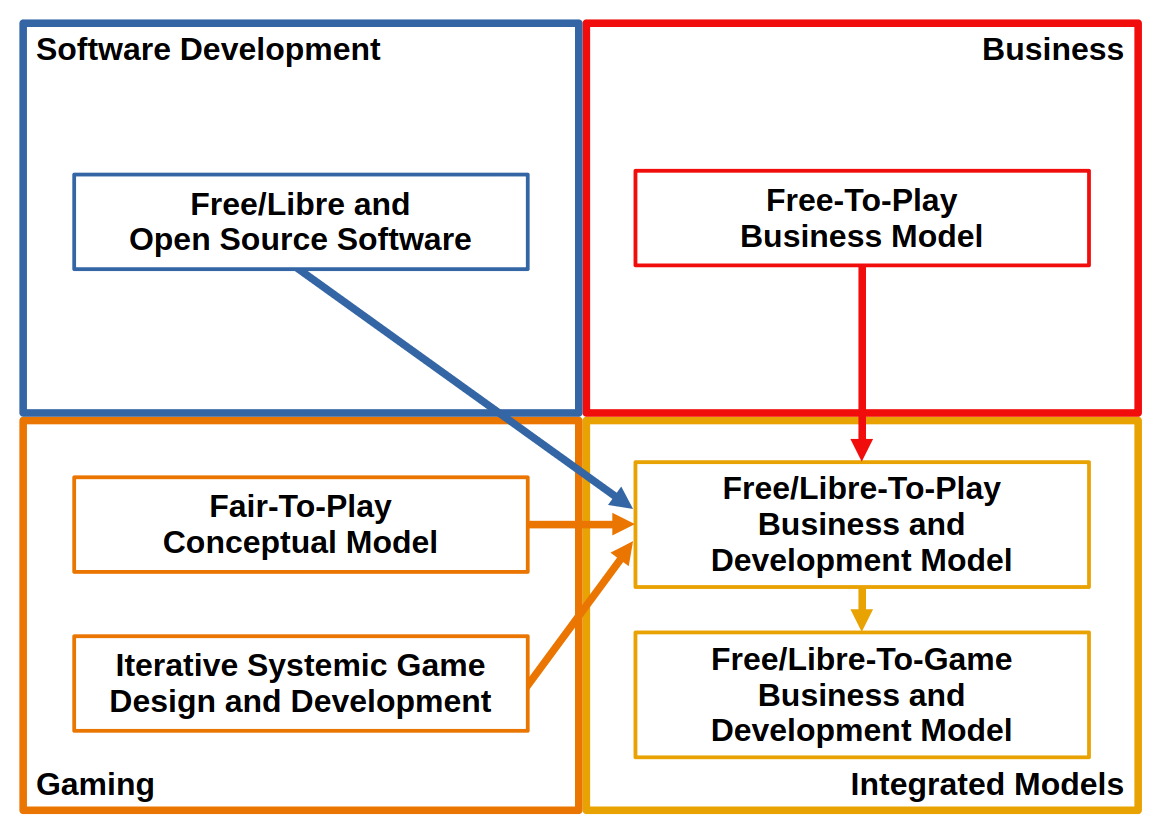1. Introduction
|
This section is currently a draft, and is subject to change. |
DGA is a free/libre and open-source, cross-platform, massively multiplayer online role-playing video game featuring weapons.
DGA implements the following concepts and models:
This chapter explains the listed concepts and models in detail.
1.1. Free/Libre and Open Source Software
Free/Libre and Open Source Software (F/LOSS) is the indisputable technological mainstream of modernity.
The concept of Free/Libre Software was pioneered by Richard Matthew Stallman who founded the Free Software Foundation (FSF) to promote computer user freedom and support the free/libre software movement.
Richard Stallman wrote and published the Free Software Definition, which provides a concise and distinguished explanation of what free/libre software is and how it must be implemented.
The open-source software movement was promoted by Bruce Perens and Eric Steven Raymond who founded an organization called Open Source Initiative (OSI) to educate about and advocate for the benefits of open-source software.
Bruce Perens and Eric Raymond drafted a set of open-source guidelines, which were adopted by the OSI as the Open Source Definition. The definition distinguishes criteria and requirements an open-source program must correspond to and serves as the most common standard for open-source software.
The figure below illustrates the notions of closed-source, free/libre, and open-source software, and shows how they are related.
A programmer writes a computer program in a programming language comfortable for humans. At this stage the program is called 'a source code program' or 'a source program' or simply 'source code'. When the source program is finished, the programmer compiles/translates source code into a computer program comfortable for execution by computers (computing machines). This program is called 'a compiled program' or 'object code'. The compiled program is the final result of the programmer’s work and suitable for distribution among users.
Proprietary Software (Closed-Source Software) requires that only the compiled program is transferred to users. The program’s source code is the private property of the programmer and/or the company the programmer is working for. An improved variation of proprietary software assumes that users can obtain the program’s source code but under the terms of some proprietary, non-free licence. For that reason, proprietary software is also called non-free software.
Free/Libre Software requires that both the compiled program and its source code must be accessible to users who, in case of need, can recompile the source code by themselves with or without modification. Moreover, a user who received the program with its source code can’t limit further distribution to other users, even when the user has modified the program; in this case, the user must distribute the modified program both in the compiled form and with its source code.
Open-Source Software implies that the computer program can be distributed as the compiled program and its source code, but both forms are not strictly required. A user can modify an open-source program and then distribute this modified program only in a compiled form without providing the modified source code. This opportunity may be used to limit the rights of other users but in some cases can be considered as noncritical or compensated by other benefits. The readiness to sacrifice the user rights to some practical benefits differs Open-Source Software from Free/Libre Software.

Figure 1.1. Free/Libre, Open-Source, and Closed-Source Software
Free/Libre Software and Open-Source Software are implemented with their software licences.
The Free Software Foundation maintains a set of licensing guidelines, which provides a non-exhaustive list of free-software licences to be used for development and distribution of free/libre software.
The Open Source Initiative maintains its proper licence review process, which defines a list of approved open-source licences that comply with the Open Source Definition.
DGA is fully and unconditionally committed to the ideas and ideals of Free/Libre Software. We strongly believe in computer user freedom and the rights of software users. Only for some limited cases, when it is appropriate, we let in the possibility of developing and distributing our programs as Open-Source Software. In every case we strive to implement the most free/libre conditions possible. Accordingly, the DGA Game supports fully and unconditionally both definitions as follows:
DGA and all its components as well as their source codes are developed and distributed under the terms of the GNU General Public Licenses (GNU GPLs) as follows:
Some components of the DGA Game, in case of necessity and appropriateness, can be developed and distributed under the terms of the Apache License as it is defined and maintained by The Apache Software Foundation:
1.2. Free-To-Play Business Model
The Free-To-Play (FTP, F2P) Business Model is an economic model that become extremely popular in gaming. Free-to-play model is also commonly referred to as free-to-start model due to not being entirely free of charge.
The Free-To-Play Business Model is a strategy employed by businesses, particularly in the digital gaming and mobile app industries where consumers can access and use a product or service without an initial purchase cost. Instead of charging upfront fees, the business generates revenue through optional in-app purchases, microtransactions, advertising, or premium content. This model aims to attract a large user base by eliminating barriers to entry and then monetize a portion of those users through various revenue streams. (FourWeekMBA)
The business model is based on the following key concepts:
-
Zero Entry Cost (Zero-Entry Barrier);
-
In-App Purchases (IAPs or microtransactions);
-
Ads and Sponsorships (Income from advertisers, sponsors, and partners);
-
Virtual Currency (In-game digital currency);
-
Premium Content (Premium features unlocked through one-time purchases or subscriptions).
The attributes below characterise free-to-play:
-
Mass User Acquisition (Acquiring a large user base);
-
Continuous Engagement (Ongoing user engagement through content updates, events, and challenges);
-
Monetisation Strategies (Diversification of revenue streams);
-
Data-Driven Optimisation (Data analytics used to refine business offerings and pricing strategies).
The free-to-play model offers several benefits and considerations:
-
Massive User Base (A massive user base increases the potential for monetisation);
-
Flexible Monetisation (Flexibility and the ability to cater to various user preferences);
-
Market Competition (Free-to-play businesses must stand out and continually innovate to succeed);
-
User Trust and Fairness (Maintaining user trust and fairness is crucial).
It is worth noting that user trust and fairness are considered as essential for the Free-To-Play Business Model in gaming. Transparency in pricing, fairness in gameplay, and responsible ad practices are vital for building and retaining a loyal user base. Users should feel that optional purchases are genuinely valuable and enhance their experience. (FourWeekMBA)
The next figure shows the graphical depiction of the free-to-play model, which is based on FourWeekMBA’s Model and extended with technical aspects.
The classic Free-To-Play Business Model assumes that the game studio makes the game as closed-source software, and therefore the development cycle is inaccessible for people outside the game studio: players, streamers, creators, developers, etc. These people form the game’s ecosystem and are involved into the game’s distribution cycle. For that reason, free-to-play in itself is often considered as a distribution model, rather than a complete business model. In reality, the way the game gets distributed influences the whole business model for the game studio.

Figure 1.2. Free-To-Play Business and Development Model
The image below shows the submodels and components of the free-to-play model and their interrelations according to FourWeekMBA’s Model.
The Free-To-Play Business Model comprises the following submodels:
-
Ecosystem (Distribution Model);
-
User Value (Value Model);
-
Revenue Streams (Financial Model);
-
Products and Services (Technological Model).

Figure 1.3. Free-To-Play Business Model’s Submodels and Components (FourWeekMBA)
The Free-To-Win (FTW, F2W) Business Model is a variation of the free-to-play model in gaming. Free-to-win affirms that a player has equal opportunities with all other players and can gain an advantage over them only by personal skills.
In fact, the free-to-win model can’t fulfill its promises because of the lack of transparency: players have no means to verify neither other players don’t have unfair advantages over them nor the game server gives preferences to some categories of players. Nowadays, both the free-to-play and free-to-win models are considered as varieties of the freemium model.
The Freemium Business Model is an economic model that offers basic services or a product for free while charging for premium features or additional content. It aims to attract a large user base with free offerings and then convert a portion of those users into paying customers by providing enhanced features or value-added services. This model is commonly used in software, gaming, and digital services industries to acquire users and generate revenue through upselling or subscription models. (FourWeekMBA)
By their closed-source nature, freemium games very quickly start to follow the pay-to-win/pay-to-earn model, which definitely assumes inequality of players when paying players have advantage over their non-paying peers. In case of subscription, the pay-to-win model works as pay-to-play games.
1.3. Fair-To-Play Conceptual Model
The Fair-To-Play (FRTP, FR2P) Model is a strategy employed by institutional and individual developers in the digital gaming and mobile app industries where gamers can verify whether the game is still a fair play or not.
The fair-to-play model is introduced by The FLEISS Software Foundation and aims to compensate deficiencies of the business and development models existing in the digital gaming industry. The key deficiency is the unfair interpretation of game cheating affirming that only players can cheat but not game developers and owners. Moreover, game developers are increasingly embedding into games anti-cheat systems, which are becoming more and more intrusive. These systems already operate at the kernel level of user operating systems, which means they have deep access to players' computers. In other words, players are always considered as potential cheaters and must prove their trustworthiness. At the same time, game developers and owners are always considered as trusted and their credibility is not in question.
The common argument explaining why game developers and owners are not interested in cheating assumes that an equal starting position for all players allows the game developers to create a more balanced game. Such a game provides a more positive experience to its players and thereby attracts more users who bring more money to the game developers and owners. Stated another way, there are compelling business reasons to prevent game developers and owners from cheating.
In reality, the game studios and their owners quite often demonstrate that their business interests are much more complicated and contradict the interests of their proper users. Gamers shall not completely depend on the game studios' goodwill towards them. Gamers shall have effective technical means to accomplish independent verification whether a game still abides by the principles of fairness, equality, justice, honesty, and integrity to its players or already not.
The next figure shows the graphical depiction of the fair-to-play model, which is based on Michael Sellers' Systemic Model of Games.
A game developed by a game studio has its game+player system containing the game’s interactive core gameplay loop. The loop is activated when a player provides input to the game via his/her behaviour, which changes the game’s state. The game processes this input and provides feedback responses that are input for the player, changing his/her internal state. These interactions create reciprocating loops that is the essence of interactivity.
While a gamer plays the game, i.e. becoming a player, the game studio uses its anti-cheating system to check the player for fair play, i.e. check that the player doesn’t cheat. In an online game the game studio can use the anti-cheating system not only on the player’s side (within the game’s client program) but also on the server side (within the game’s servers). That is how the games work today.
The fair-to-play model requires that the gamer must have technical means to check the game for fair play, i.e. the player of the game must have the same rights as the game studio does. The game studio must provide these means to the gamers. In this case the game can be recognised as fair to play.

Figure 1.4. Fair-To-Play Conceptual Model
Fair-to-play in itself is a conceptual model, which can be implemented in different business and development models. So, 'game studio' can be a company, non-commercial organisation, team, or individual developer.
1.4. Free/Libre-To-Play Business and Development Model
The Free/Libre-To-Play (FLTP, FL2P) and Free/Libre-To-Game (FLTG, FL2G) Models are business and development models introduced by The FLEISS Software Foundation as implementations of the Fair-To-Play Conceptual Model.
The free/libre-to-play model implements the principles of fair-to-play by following the way of Free/Libre and Open Source Software.
F/LOSS is the most consistent approach to ensure fair play in digital games.
The free/libre-to-play model is based on the following approaches and models:
-
Free/Libre and Open Source Software as the strategic approach in software development.
-
Free-To-Play Business Model as the basic business model for further improvement.
-
Fair-To-Play Conceptual Model as the strategic approach in gaming.
-
Iterative Systemic Approach in game design and development.
The figure below shows the graphical depiction of free/libre-to-play.
A game studio implements a game within an iterative development cycle. Since the game is a free/libre/open-source software program, the game’s community is an integral part of the game’s ecosystem.
The game studio and game community form the common ecosystem of the game and are inseparable. Employees working at the game studio, the game’s users, and the game community’s participators, contributors, and leaders can be the same persons, which activities are interrelated and interconnected. This interconnection may create some conflicts of interest, when a person is an employee of the game studio and at the same time an active member of the game community, but these conflicts can be effectively arranged.
The working process conducted at the game studio and various activities going on within the game community constitute the game’s business and development workflow.

Figure 1.5. Free/Libre-To-Play Business and Development Model
1.5. Free/Libre-To-Game Business and Development Model
The Free/Libre-To-Game Business and Development Model is an advanced version of free/libre-to-play and serves as a superior implementation of the fair-to-play concept.
The free/libre-to-game model takes into account the architecture of multitier game systems and requires that not only a game’s client but all the game’s server components must be free/libre/open-source software.
When a game can be played in a single-player mode only, the free/libre-to-play model is sufficient to ensure the game is fair-to-play. Such a game has only a client program installed on the gamer’s computer and does not require interaction with remote servers to be played.
Whereas the game is a multiplayer one and requires continuous interactions with remote servers, the game client’s source code accessible to the gamers is not sufficient to ensure fair-to-play, since the game servers can still remain closed-source software. This situation is not adequately covered by the free/libre-to-play model.
Here free/libre-to-game comes into action. The model stipulates that not only the game’s client installed on the player’s side and sufficient to play the game, but also the game’s servers and other components and services necessary for the game to be played — all of them must be free/libre/open-source software. The gamers must have opportunity to rebuild the game’s client and servers from their source codes and reproduce the game’s infrastructure to verify its fairness, equality, justice, honesty, and integrity.
The figure shows the concepts and models free/libre-to-play and free/libre-to-game are based on and interrelated.

Figure 1.6. Free/Libre-To-Play and Free/Libre-To-Game Models
The free/libre-to-game model is the basis for design, development, and distribution of the DGA Game.
Want to help? Learn how to contribute to FLEISSF DGA Docs


